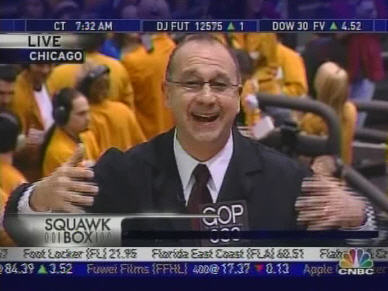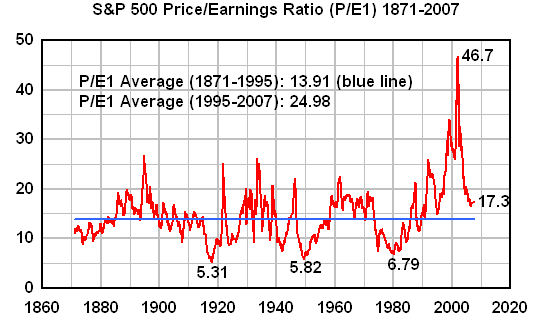
Dynamics

|
Generational Dynamics |
| Forecasting America's Destiny ... and the World's | |
| HOME WEB LOG COUNTRY WIKI COMMENT FORUM DOWNLOADS ABOUT | |
First quarter corporate earnings estimates fell again, driving up P/E ratios.
There's a price/earnings ratio chart at the bottom of this web site's home page, and it gets updated automatically every Friday. Here's the April 11 version of the chart:
 |
As you can see from the region circled in red, the p/e ratio has spiked upward to its highest value since 2005. This is a sudden and unexpected change.
For the past couple of years, p/e ratios (also called "valuations") have remained close to 18. This indicates that investors have all been following the same formulas in deciding whether to buy or sell stocks, and that stock prices have gone up or down as corporate earnings estimates have gone up or down.
That link was suddenly broken in the last couple of weeks. Corporate earnings estimates have fallen dramatically recently (see below), but investors have been keeping stock prices fairly steady.
Why aren't investors selling off? The answer appears to be that investors have concluded that the "credit crunch" and "asset writedowns" are pretty much over.
 |
One of the most gushing spokemen for this point of view is CNBC contributor Jack Bouroudijian, appearing on Monday morning, when he said the following:
I talk to portfolio managers that have been sitting on hordes of cash. We're talking about piles of cash, whether it be in London, whether it be in Singapore. They're waiting for the right moment for that money to get invested in this country, in our markets. And remember, our markets are more than just US equities. These are global corporations, headquartered in the US. They're waiting for the right moment, they're starting to trickle in. ...
The economic seizure that we just went through ... over the last six months -- that is what I'm talking about. It took a few months to work through the SEIZE in the market.
What we're looking at now is the situation where the economy is working its way through all of that, and now it's a question right now of whether you have the GUTS to be buying this market right now, instead of selling.
The credit crunch was nothing more than a seizure of the entire credit markets. That had to be worked out."
It's hard to see why any part of this is anything but wishful thinking on Bouroudijian's part. In fact, Bouroudijian was saying all this on Monday morning just at the time that Wachovia was announcing a large new asset writedown, and much lower than expected first quarter earnings.
Still, Bouroudijian's outlandish statements appear to be widely held among investors, and many of them are expecting stock market bubble to start growing again.
In fact, the upward spike in price/earnings ratios really portends a further plummeting of the stock market, if we believe the trends of the last 2-3 years. Once investors realize that the lower earnings are for real, they'll presumably all go back to following the same formula as ever, and drive stock prices down again.
Finally, let's update our table of corporate earnings estimates. Each week, we add a line to the table indicating the estimates of first quarter corporate earnings as of that week.
Here's the summary from Friday from CNBC Earnings Central:
32 companies in the S&P 500 have reported earnings for Q1, 71.88% have beaten estimates, 9.38% were in-line, and 18.75% have missed. (Data provided by Reuters Estimates)
The blended earnings growth rate for the S&P 500 in first-quarter 2008, combining actual numbers for companies that have reported, and estimates for companies yet to report, fell to -14.1% from -12.2% due in part to lower earnings from General Electric and downward revisions to the Financials.
On January 1st, the estimated growth rate for Q1 was 5.7%. (Data provided by Thomson Financial)"
This allows us to add one more line to our table, as follows:
Date 1Q Earnings estimate as of that date ------- ------------------------------------ Oct 23: +10.0% Jan 1: +5.7% Feb 6: +2.6% Feb 29: -1.1% Mar 7: -4.3% Mar 14: -7.8% Mar 21: -7.9% Mar 28: -9.3% Apr 4: -12.2% Apr 11: -14.1%
We're in the familiar pattern of continually falling earnings estimates. The only thing that hasn't happened is that investors haven't pushed stock prices down to follow the earnings down. That will presumably happen soon.
From the point of view of Generational Dynamics, what we're expecting is a generational panic and stock market crash, the first since 1929. This is indicated by the following historical p/e ratio chart:
 |
P/E ratios have been historically above average since 1995, and by the Principle of Mean Reversion, will have to fall to historically below average values for a roughly equal amount of time. Several times in the last century, and as recently as 1982, P/E ratios have fallen to the 5-6 level, and that kind of fall seems to be imminent again.
A generational panic and crash is an event that will make history. It's impossible to predict exactly when it will happen, and it's folly to even guess, but that doesn't seem to prevent me from wanting to try to guess anyway. Actually, all I want to do is make one observation: That the the 1929 crash occurred on October 24, in the third week of the quarter. Nobody has convincingly identified any event that triggered the 1929 crash, but one possibility that's occurred to me is that the announcement of lower corporate earnings for the third quarter of 1929 was the trigger. I haven't checked this out, and I don't even know where I'd find those earnings figures, but if earnings announcements were lower than expected, it would make sense that the panic was triggered by that.
That's just a guess, however. Beyond that, I just use a kind of "safe harbor" statement by saying that I've estimated that the probability of a major financial crisis (generational stock market panic and crash) in any given week from now on is about 3%. The probability of a crisis some time in the next 52 weeks is 75%, according to this estimate.
Investors appear to be anything but panicked right now, especially in
view of the sudden and unexpected upward spike in price/earnings
ratios. It's almost as if investors are holding their collective
breaths, waiting to see what will happen next, hoping the next couple
of weeks will bring higher than expected first quarter earnings
reports. Unless earnings reports are unexpectedly high, the
continuing fall in earnings estimates portends a fall in the stock
market indexes, irrespective of when a panic occurs.
(15-Apr-08)
Permanent Link
Receive daily World View columns by e-mail
Donate to Generational Dynamics via PayPal
Web Log Summary - 2016
Web Log Summary - 2015
Web Log Summary - 2014
Web Log Summary - 2013
Web Log Summary - 2012
Web Log Summary - 2011
Web Log Summary - 2010
Web Log Summary - 2009
Web Log Summary - 2008
Web Log Summary - 2007
Web Log Summary - 2006
Web Log Summary - 2005
Web Log Summary - 2004
Web Log - December, 2016
Web Log - November, 2016
Web Log - October, 2016
Web Log - September, 2016
Web Log - August, 2016
Web Log - July, 2016
Web Log - June, 2016
Web Log - May, 2016
Web Log - April, 2016
Web Log - March, 2016
Web Log - February, 2016
Web Log - January, 2016
Web Log - December, 2015
Web Log - November, 2015
Web Log - October, 2015
Web Log - September, 2015
Web Log - August, 2015
Web Log - July, 2015
Web Log - June, 2015
Web Log - May, 2015
Web Log - April, 2015
Web Log - March, 2015
Web Log - February, 2015
Web Log - January, 2015
Web Log - December, 2014
Web Log - November, 2014
Web Log - October, 2014
Web Log - September, 2014
Web Log - August, 2014
Web Log - July, 2014
Web Log - June, 2014
Web Log - May, 2014
Web Log - April, 2014
Web Log - March, 2014
Web Log - February, 2014
Web Log - January, 2014
Web Log - December, 2013
Web Log - November, 2013
Web Log - October, 2013
Web Log - September, 2013
Web Log - August, 2013
Web Log - July, 2013
Web Log - June, 2013
Web Log - May, 2013
Web Log - April, 2013
Web Log - March, 2013
Web Log - February, 2013
Web Log - January, 2013
Web Log - December, 2012
Web Log - November, 2012
Web Log - October, 2012
Web Log - September, 2012
Web Log - August, 2012
Web Log - July, 2012
Web Log - June, 2012
Web Log - May, 2012
Web Log - April, 2012
Web Log - March, 2012
Web Log - February, 2012
Web Log - January, 2012
Web Log - December, 2011
Web Log - November, 2011
Web Log - October, 2011
Web Log - September, 2011
Web Log - August, 2011
Web Log - July, 2011
Web Log - June, 2011
Web Log - May, 2011
Web Log - April, 2011
Web Log - March, 2011
Web Log - February, 2011
Web Log - January, 2011
Web Log - December, 2010
Web Log - November, 2010
Web Log - October, 2010
Web Log - September, 2010
Web Log - August, 2010
Web Log - July, 2010
Web Log - June, 2010
Web Log - May, 2010
Web Log - April, 2010
Web Log - March, 2010
Web Log - February, 2010
Web Log - January, 2010
Web Log - December, 2009
Web Log - November, 2009
Web Log - October, 2009
Web Log - September, 2009
Web Log - August, 2009
Web Log - July, 2009
Web Log - June, 2009
Web Log - May, 2009
Web Log - April, 2009
Web Log - March, 2009
Web Log - February, 2009
Web Log - January, 2009
Web Log - December, 2008
Web Log - November, 2008
Web Log - October, 2008
Web Log - September, 2008
Web Log - August, 2008
Web Log - July, 2008
Web Log - June, 2008
Web Log - May, 2008
Web Log - April, 2008
Web Log - March, 2008
Web Log - February, 2008
Web Log - January, 2008
Web Log - December, 2007
Web Log - November, 2007
Web Log - October, 2007
Web Log - September, 2007
Web Log - August, 2007
Web Log - July, 2007
Web Log - June, 2007
Web Log - May, 2007
Web Log - April, 2007
Web Log - March, 2007
Web Log - February, 2007
Web Log - January, 2007
Web Log - December, 2006
Web Log - November, 2006
Web Log - October, 2006
Web Log - September, 2006
Web Log - August, 2006
Web Log - July, 2006
Web Log - June, 2006
Web Log - May, 2006
Web Log - April, 2006
Web Log - March, 2006
Web Log - February, 2006
Web Log - January, 2006
Web Log - December, 2005
Web Log - November, 2005
Web Log - October, 2005
Web Log - September, 2005
Web Log - August, 2005
Web Log - July, 2005
Web Log - June, 2005
Web Log - May, 2005
Web Log - April, 2005
Web Log - March, 2005
Web Log - February, 2005
Web Log - January, 2005
Web Log - December, 2004
Web Log - November, 2004
Web Log - October, 2004
Web Log - September, 2004
Web Log - August, 2004
Web Log - July, 2004
Web Log - June, 2004